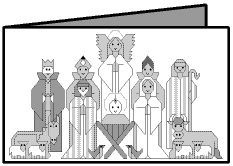Or search by topic
Number and algebra
Geometry and measure
Probability and statistics
Working mathematically
Advanced mathematics
For younger learners
Sending and Receiving Cards



- Problem
- Getting Started
- Student Solutions
- Teachers' Resources
Sending & Receiving Cards
There are many festivals and celebrations when we send cards to each other. Some schools organise a postal service within the school and some of the pupils get the job of being postmen/women.
Groups of children send cards to each other sometimes and that's really good for them all; it's a good feeling getting the cards.
Suppose there are three children, Georgie, Jo and Chris, and these three are really good friends. They decide to send cards to each other.
Georgie sends two cards, one to Jo and one to Chris.
Jo sends two cards, one to Georgie and one to Chris.
Chris sends two cards, one to Jo and one to Georgie.


So these three friends send six cards altogether. Also they get six cards altogether!!!!
What if in another class in that school there is a group of four children who are best friends and at this time of the year each sends the others a card.
Raj sends $3$ cards, one to Bex, one to Jon and one to Loo.
Bex sends $3$ cards, one to Raj, one to Jon and one to Loo.
Jon sends $3$ cards....
Loo sends $3$ cards....
So a lot more cards are sent by the four children altogether.
This season's challenge is to explore the number of cards that are sent altogether when there are $5$ children, then $6$, then $7$, etc. , up to perhaps a class of $30$ children who all send cards to each other and you work out how many cards are sent altogether.
Once you have this set of numbers it might be good to write them down underneath one another (a bit like you may have done when you did the investigation called Exploring Wild & Wonderful Number Patterns ).
You could now, if you have not done it already, start looking at some of the things that pop up in this number pattern. I'm not sure what they all are of course, but I've seen a few patterns, so get searching for what YOU can find!
Then you'll be able to ask, "I wonder what would happen if I ...?'' about so many things.
Why do this problem?
Possible approach
Key questions
Possible extension
For the exceptionally mathematically able
Possible support
You may also like
Consecutive Numbers
An investigation involving adding and subtracting sets of consecutive numbers. Lots to find out, lots to explore.
Tea Cups
Place the 16 different combinations of cup/saucer in this 4 by 4 arrangement so that no row or column contains more than one cup or saucer of the same colour.
Tiles on a Patio
How many ways can you find of tiling the square patio, using square tiles of different sizes?

